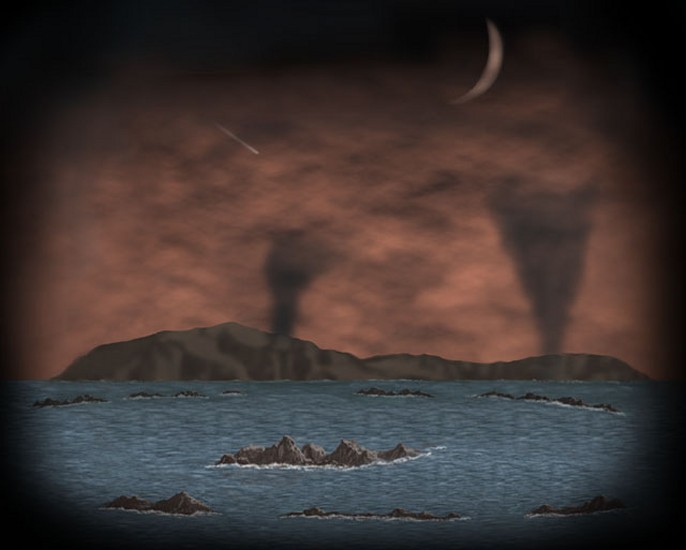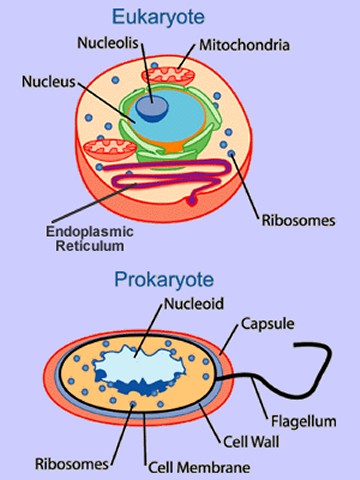
|
Main Topics > The Beginnings of Life > The Early Earth and the Building Blocks of Life
The Earth was formed about 4.5 billion years ago from the swirling dust and gas remnants of an old star’s supernova explosion. As the molten mass settled and cooled, a solid crust soon formed, probably within as little as about 150 million years, along with a rudimentary atmosphere composed largely of carbon dioxide, water vapor and nitrogen. After a near-catastrophic collision with another planet soon after the Earth's formation (which created the Moon in the process), it is thought that warm oceans gradually formed, from steam escaping from the crust and from volcanic activity and icy meteorites, relatively soon after the Earth’s formation, perhaps within 750 million years of Earth's formation (about 3.8 billion years ago).
Although the environment at that time (including the constant bombardment by asteroids and prodigious volcanic activity) would have been highly hazardous to life, the necessary ingredients were all present in some form or another: liquid water, chemical building blocks (usually taken to be the six elements: oxygen, hydrogen, carbon, nitrogen, sulphur and phosphorus) and some kind of energy source. Liquid water is considered essential to the initial development of life because many chemicals dissolve easily in water allowing them to mix together and react, because liquid water is the right temperature for chemical reactions to happen, and also because many chemicals have parts which are attracted to water and parts which are repelled by it (which also helps reactions happen). Carbon is important because of its ability to form long chain-like molecules (carbon chains form the backbone of organic molecules). Hydrogen and oxygen (the two elements that make up water molecules) as well as nitrogen can all bond with carbon in many different ways, and large molecules made from carbon, hydrogen, oxygen and nitrogen also tend to be very stable. All chemical reactions need an energy source to drive them, whether it be ultraviolet light from the Sun or electrical energy from lightning or chemical energy from deep-sea vents, all of which would have been available on the early Earth. Cyanobacteria (also known as blue-green algae), one of the earliest types of prokaryotic bacteria, formed into colonies or mats called stromatolites, and fossilized remains of these have been found in Australia dating back to between 3.4 and 2.8 billion years ago. Ancient as their origins are, these bacteria (which are still around today) were already biologically complex, with cell walls protecting their protein-producing DNA, so scientists think it likely that life actually began much earlier, perhaps as early as 3.8 billion years ago. These early cyanobacteria were the first oxygen-producing, evolving, phototropic organisms, and they were responsible for the initial oxygenation of the Earth's atmosphere, as they produced oxygen while sequestering carbon dioxide in organic molecules during the period from 2.7 to 2.2 billion years ago. Photosynthesizing plants evolved later and continued this process, leading to the build up of increasing levels of oxygen in the atmosphere, as well as the release of nitrogen into the atmosphere as the oxygen reacted with ammonia. Eventually, a layer of ozone (an allotrope of oxygen) formed in the atmosphere, which better protected early lifeforms from ultraviolet radiation. While oxygen was apparently not needed for the origination of life on Earth (indeed it is thought by many that the absence of oxygen was a necessary condition), the rapid explosion of life began only after oxygen became abundant.
The first eukaryotic cells (organisms with one or more complex cells, each of which contains a nucleus and is surrounded by a membrane that holds the cell’s genetic material) evolved sometime between 2.5 and 1.7 billion years ago, perhaps coincident with the rise in atmospheric oxygen to a level able to support this more complex life. The nucleus in these cells was able to hold and protect complex molecules such as RNA and DNA. Throughout the Proterozoic era, from about 2.3 billion years ago until around 600 million years ago, life on Earth was mostly single-celled and small, consisting of bacteria, archaea and eukaryotic algae. The first multi-cellular life probably arose around 1.2 billion years ago, in geological terms almost overnight, while the landmass of the Earth was still a single continent called Rodinia. It presumably started out as a sort of symbiosis, a loose cooperation between single cells that gradually became more and more complex. Recent research on single-celled organisms called choanoflagellates has yielded the rather surprising fact that single-celled organisms began communicating with each other (and effectively working together as a single unit) due to a random mutation in a single gene, a fascinating illustration of how a tiny genetic change can have huge repercussions. Evolution appeared to speed up again about 550 million years ago with the sudden appearance of the first hard-bodied animals in the fossil record. As recently as the 1970s, a whole new group of single-celled organisms known as archaea was discovered, which is now recognized as a third domain of life, completely separate from both prokaryotes and eukaryotes. Many scientists believe archaea to be the common ancestor of both prokaryotes and eukaryotes, and as such may represent the oldest form of life on earth.
|
Back to Top of Page
Introduction | Main Topics | Important Dates and Discoveries | Important Scientists | Cosmological Theories | The Universe By Numbers | Glossary of Terms | A few random facts | Blog | Gravitational Lensing Animation | Angular Momentum Calculator | Big Bang Timeline
NASA Apps - iOS | Android
The articles on this site are © 2009-.
If you quote this material please be courteous and provide a link.
Citations | Sources | Privacy Policy

